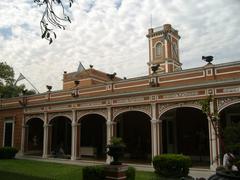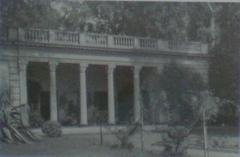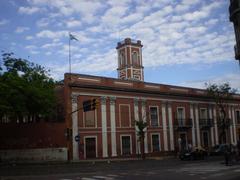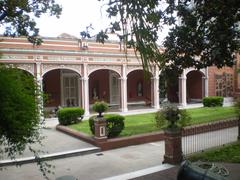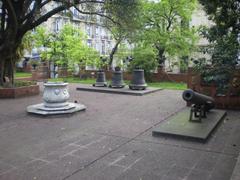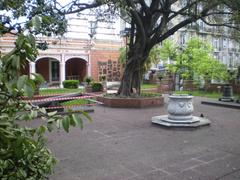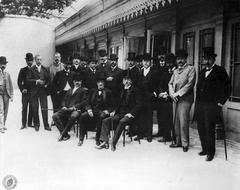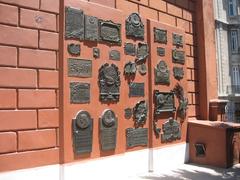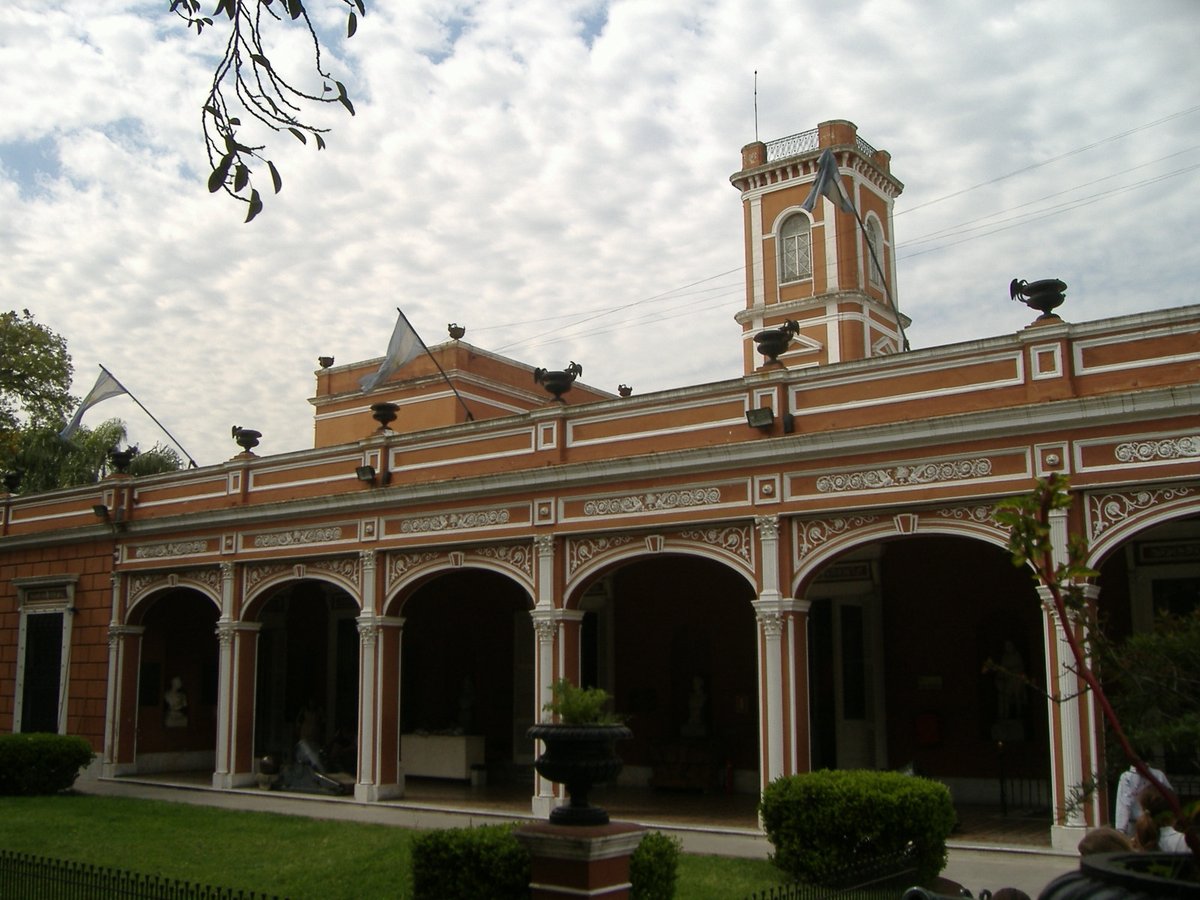
National Historical Museum Buenos Aires: Visiting Hours, Tickets, and Comprehensive Travel Guide
Date: 14/06/2025
Introduction
Nestled in the historic San Telmo neighborhood, the National Historical Museum Buenos Aires (Museo Histórico Nacional) is a gateway to Argentina’s vibrant and complex history. Established in 1889 and housed in a stately 19th-century mansion, the museum showcases more than 50,000 artifacts ranging from the colonial era, the May Revolution of 1810, and the Argentine War of Independence, to the formation of the republic and beyond. Its rich collections, engaging exhibitions, and central location make it a must-visit for history enthusiasts and cultural travelers alike. (Welcome Pickups, Buenos Aires Tourism, Museo Histórico Nacional Official Website)
Table of Contents
- Introduction
- Origins and Historical Context
- The Museum Building: Architectural Heritage
- Museum Collections: Highlights and Permanent Exhibitions
- Visiting Hours and Ticket Information
- Accessibility and Visitor Services
- Guided Tours and Educational Programs
- Travel Tips and Nearby Attractions
- Practical Visitor Information
- Frequently Asked Questions (FAQ)
- Visuals and Media
- Contact Information and Further Resources
- COVID-19 Protocols
- Currency, Payments, and International Visitor Tips
- Conclusion and Final Tips
Origins and Historical Context
The museum was founded in 1889 during a period of growing national consciousness, with the mission to preserve and celebrate the pivotal events and figures in Argentina’s history. Spearheaded by Mayor Francisco Seeber, it was intended as a repository for artifacts and documents relating to the May Revolution and the nation’s struggle for independence. Over the years, its collection has grown through generous donations from the descendants of key historical figures and acquisitions from earlier museums. (Welcome Pickups)
The Museum Building: Architectural Heritage
From Mansion to Museum
The museum is housed in a mansion originally built in 1846 for American businessman Charles Ridgley Horne. Its neoclassical and eclectic architecture—marked by grand facades, high ceilings, and ornate details—captures the elegance of 19th-century Buenos Aires. In 1889, the residence was converted into the National Historical Museum, undergoing subsequent expansions and adaptations to accommodate its growing collections and visitors. (Buenos Aires Tourism)
Architectural Features
The building blends neoclassical symmetry with eclectic flourishes, such as wrought-iron railings and decorative moldings. Its layout, featuring spacious rooms and courtyards, offers a fitting setting for exploring Argentina’s past. The surrounding Lezama Park adds a tranquil, green backdrop to the historic site.
Museum Collections: Highlights and Permanent Exhibitions
The museum boasts over 50,000 items that chronicle Argentina’s evolution from colonial times to the modern era.
Historical Artifacts and Regalia
- Army of the Andes Flag: The original flag used by General José de San Martín during the liberation campaigns—a symbol of Argentine and South American independence.
- Personal Effects of National Heroes: Sabres, uniforms, and belongings of San Martín, Manuel Belgrano, María de los Remedios de Escalada, Juan Manuel de Rosas, and others.
- Battle Relics: Flags, military regalia, and weaponry from key battles like Ayohúma.
Paintings and Visual Arts
- Cándido López Collection: Panoramic paintings documenting the Paraguayan War, offering unique historical and artistic perspectives.
- Other Artists: Works by Esteban Echeverría, Prilidiano Pueyrredón, and notable 19th- and early 20th-century artists that illustrate Argentina’s changing identity.
Everyday Life and Social History
- Period Furniture and Clothing: Artifacts reflecting the domestic and social customs of 19th-century Argentina.
- Textiles and Costumes: Military and civilian dress, charting the evolution of Argentine fashion.
Documents and Manuscripts
- Historic Documents: Original decrees from the May Revolution, personal correspondence of independence leaders, and colonial maps.
Must-See Permanent Exhibitions
- “Tiempo de Revolución” (Times of Revolution): Immersive displays of weapons, documents, and personal effects from 1808–1824.
- The Mansion and Lezama Park: The former Lezama family mansion and the neighboring park create a unique historical environment.
Visiting Hours and Ticket Information
- Location: Defensa 1600, San Telmo, Buenos Aires (adjacent to Lezama Park)
- Hours:
- Wednesday to Friday: 11:00 AM – 7:00 PM
- Saturday: 11:00 AM – 9:00 PM
- Sunday: 11:00 AM – 7:00 PM
- Closed: Mondays and Tuesdays
- Admission: Free general entry; voluntary donations appreciated for museum upkeep. Some special exhibitions or tours may require a fee.
- Group visits or educational tours: May require advance booking. (Museo Histórico Nacional Official Website)
Accessibility and Visitor Services
- Physical Accessibility: Ramps, elevators, and accessible restrooms are available, though some areas may present challenges due to the building’s historic nature.
- Audio Guides: Available in English and Spanish for a fee.
- Restrooms and Cloakroom: On-site amenities include restrooms and storage for small bags and coats.
- Gift Shop: Offers books, educational materials, and souvenirs.
Guided Tours and Educational Programs
- Guided Tours: Regular tours in Spanish and English (English tours typically at 12:00 Wednesday–Friday; check schedules onsite or online).
- Workshops and Seminars: Thematic programs for all ages, including interactive activities aligned with school curricula.
- Temporary Exhibitions and Events: Regularly updated cultural events, lectures, and historical reenactments. (Welcome Pickups, Museo Histórico Nacional Official Website)
Travel Tips and Nearby Attractions
- Best Time to Visit: Weekday mornings or Wednesdays for fewer crowds and free admission.
- Nearby Attractions: San Telmo Market, Plaza Dorrego, El Zanjón de Granados, and the vibrant Sunday Fair.
- Dining: While there’s no café inside, San Telmo offers excellent options nearby.
- Photography: Permitted without flash or professional equipment (observe signage for restrictions).
Practical Visitor Information
- Public Transport: Easily accessible via bus, Subte (Independencia station, Lines C and E), taxi, and ride-sharing. Bike racks are available.
- Duration: Allocate 1.5–2 hours to fully explore the museum.
- Language: Most signage is in Spanish; translation apps or audio guides in English recommended.
- Dress Code: Comfortable shoes are advised; the museum is climate-controlled.
Frequently Asked Questions (FAQ)
Q: What are the visiting hours?
A: Wednesday–Friday 11:00–19:00, Saturday 11:00–21:00, Sunday 11:00–19:00. Closed Mondays and Tuesdays.
Q: Is admission free?
A: Yes, general admission is free; special exhibitions or guided tours may incur a fee.
Q: Are guided tours available in English?
A: Yes, check the schedule at the information desk or online for English-language tours.
Q: Is the museum accessible for visitors with disabilities?
A: Yes, with ramps and accessible restrooms, though some areas may be less accessible.
Q: Can I take photos?
A: Photography is allowed without flash or tripods; confirm for special exhibits.
Visuals and Media
- Interactive maps and virtual tours are available on the official website.
- Recommended photo spots: museum entrance, grand staircases, and key artifacts like the Army of the Andes flag and Cándido López paintings.
Contact Information and Further Resources
- Website: museohistoriconacional.cultura.gob.ar
- Phone: +54 11 4300-1280
- Email: [email protected]
For updates on hours, exhibitions, and special events, consult the official website or follow the museum’s social media channels.
COVID-19 Protocols
As of June 2025, most restrictions have been lifted. Hand sanitizers are available throughout the museum. Check the museum’s website for the latest health and safety updates.
Currency, Payments, and International Visitor Tips
- Currency: Argentine pesos are preferred for purchases; cards accepted in most locations.
- Language: English is spoken in many nearby establishments, but basic Spanish phrases are helpful.
- Tourist Friendliness: The area is safe and well-patrolled.
Conclusion and Final Tips
The National Historical Museum Buenos Aires is a cornerstone of Argentina’s cultural heritage, offering free access to a rich collection of artifacts, engaging exhibitions, and educational programs. Its location in San Telmo, accessible facilities, and multilingual services make it ideal for both local and international visitors. For the best experience, visit on weekday mornings, utilize guided tours or audio guides, and explore nearby attractions for a full day of historical discovery. Don’t forget to download the Audiala app for guided audio tours and stay connected with museum updates.
Embark on your journey through Argentina’s history—where each artifact tells a story and every room echoes with the legacy of a nation.
(Museo Histórico Nacional Official Website, Buenos Aires Tourism, Welcome Pickups, WhichMuseum, The Broke Backpacker)
